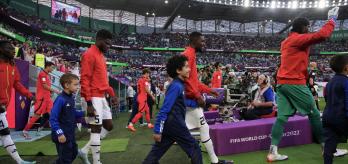Key Observations
-
Giving playing opportunities to young players before their 23rd birthday is crucial for raising their competitiveness and giving them exposure to a first-team environment. Giving promising youngsters meaningful playing opportunities also makes it more likely clubs can raise their market value. The German Bundesliga is a perfect example of giving promising young players a chance.
-
The number of foreign internationals within the Big Five league competitions is also helping to train and develop home-grown players from the Big Five nations by increasing the quality of competition. For instance, leagues like France and England are building "Best vs Best" environments that are a key ingredient for optimising player development.
The transition phase
For promising young footballers, their 23rd birthday marks a significant milestone. For official purposes at least, it marks the point at which they cease to be considered youngsters and become established as senior professionals. To navigate this transition successfully, young players need to accumulate plenty of game-time by the time they reach the age of 23. As the final chapter of our report shows, official "B" and reserve teams can play a key role in this regard.
Between their debuts in senior leagues and their 23rd birthdays, the 830 players selected for the FIFA World Cup Qatar played official matches (in domestic or international club competitions) for a total of 763 clubs. This result shows the extent of the teams involved in the development of top-level players. It also confirms the close interweaving and interdependence between clubs of different sporting and economic levels in the paths that lead players to a successful career.
Breakdown of transition clubs
Of the clubs represented at FIFA World Cup 2022, AFC Ajax gave players most game-time under the age 23, amounting to 1,962 official matches and 147,618 minutes. It is notable that the clubs that have made the biggest contributions to developing players at Qatar 2022 by this measure all have at least three characteristics in common: expertise in developing young players, a policy of recruiting talent early, and the willingness to give them game-time, either in their first teams or in their B-teams.
Environmental factors at play
In both national and local contexts, environmental factors can also be decisive for clubs' ability to train and develop young players. Examples include the specific rules and regulations adopted by national associations and professional leagues to encourage the development of young players, systems of financial support, and the way youth coaches are trained to work with young players. Senior leaders within clubs also play a key role in shaping their clubs' youth development systems, as it is their responsibility to draw up a clear vision with this aim in mind, and to develop the strategies required to achieve it.
Significance of B-teams
If we consider the ten clubs that have contributed most to the development of players at FIFA World Cup 2022, it is striking that all ten have B-teams playing within their respective countries' professional league structures. Most play in the third tier of the domestic league pyramid or below, but there are exceptions, such as AFC Ajax's B-team, which plays in the Dutch second tier.
These B-teams played a key role in helping many of the players selected for the 2022 World Cup to transition from youth to senior football, and Real Madrid CF is a striking example. Of the current or former Real Madrid players at the 2022 World Cup, 36.6% of the game-time they accumulated for the club in official matches before the age of 23 came in their B-Team, Real Madrid Castilla CF. The same principle can be seen in relation to AFC Ajax where, despite the fact it is potentially easier for young players to make the first team than it would be at Real Madrid, 17.9% of total game-time before the age of 23 came for the B-team. In total, and without even considering games played by B-teams that play in dedicated reserve leagues, as is the case in England, 7.7% of the total minutes played by FIFA 2022 World Cup players before turning 23 were accumulated in the second or third teams of clubs whose first teams play in the top division.
Where players play during their transition phase
The map below shows the locations of the 763 clubs where players at FIFA World Cup Qatar 2022 played in senior competitions before their 23rd birthdays, and again demonstrates the predominance of Europe. Not only is the "old continent" the region with the largest number of teams at the tournament, but its clubs also develop many players of non-European associations, either by recruiting them at a young age from their country of origin, or by taking the children of immigrant parents living locally into their youth academies who go on to be selected by the country their parents came from.
Hubs for youth development
In terms of the leagues where players taking part in the FIFA World Cup Qatar 2022 played official matches under the age of 23 (not including domestic or continental cup competitions), the German Bundesliga is at the top of the list. No fewer than 99 players selected for the 2022 World Cup, representing 25 different national teams between them, played Bundesliga matches at the beginnings of their careers. Although a slightly higher number of players played in the English Premier League under the age of 23 (110), they spent fewer minutes on the pitch between them.











